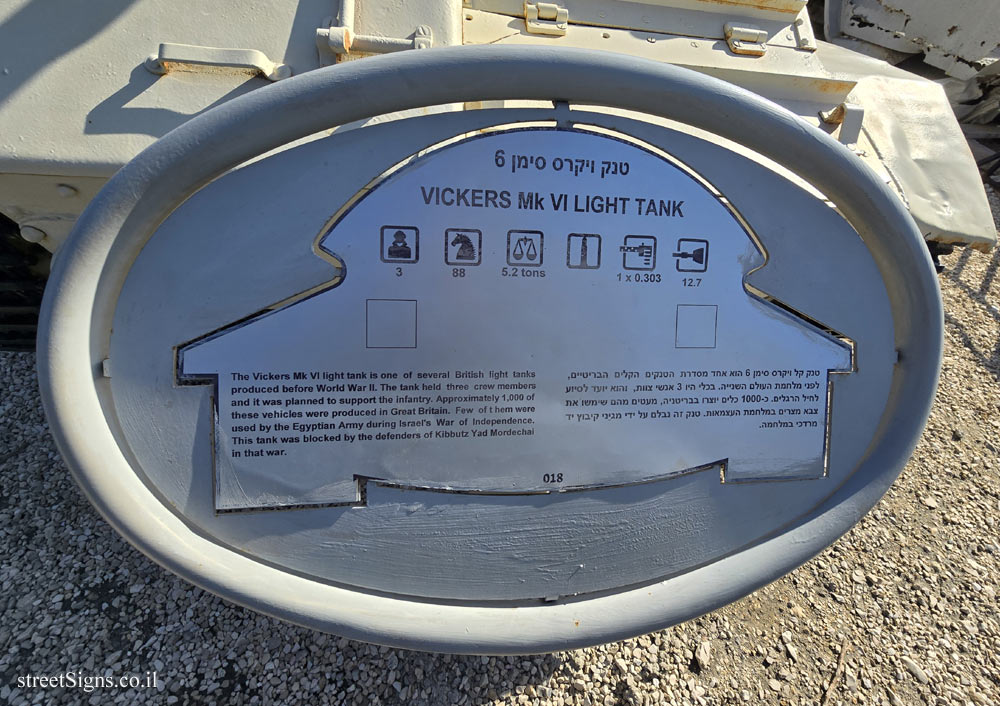Behind the monument stands an identical monument in which the text appears in the English language.
The story of the battle is also described on a sign of heritage sites in Israel
 Click for sign's details
Click for sign's details The Egyptian tank that was stopped by the defenders of the kibbutz is a Vickers Mark 6 tank
 Click for sign's details Translation of the text on the sign
Click for sign's details Translation of the text on the sign:
[It is difficult to read the text in the second monument, so a translation of the first is provided]
[Shani Battalion badge - Negev Brigade]
Battles at the hands of Mordechai
May 18 to 24, 1948 Kibbutz Yad Mordechai, named after Mordechai Anilevich, one of the commanders of the uprising in the Warsaw Ghetto, came up on the ground in December 1943, on hills about 180 meters west of the Gaza-Majdal road. At the beginning of the War of Independence, the kibbutz was cut off. Like the other localities in the area, contact with them was maintained through convoys As part of the Southern Defense Organization, it was determined that the kibbutz is within the area of responsibility of the Negev Division of the Palmach.
With the end of the mandate, the Egyptian army invaded Israel and advanced north on the main road east of the kibbutz. At that time, the kibbutz was defended by about 100 fighters (members and companies of the kibbutz and Palmach personnel), equipped with personal weapons and a few auxiliary weapons. On the evening of May 18, 1948, the Egyptian attack began with aerial bombardment and artillery bombardment. At midnight the children and some of the women were evacuated from the kibbutz. The next morning A ground attack by a company from the Egyptian 1st Rifle Battalion began. Aided by artillery and armor and covered by smoke. After an initial success in occupying an external position (the pillbox), the attack was repelled, as were the repeated attacks that continued until the next day (20.5).
On the night of 11/20, reinforcements from two Palmach squads arrived at the kibbutz along with their weapons. After two days of Egyptian artillery fire, the Egyptian ground attack resumed on May 23. This time using two companies from the 2nd Rifle Battalion. The attack was led by a tank that managed to break through the fence of the kibbutz, the tank was stopped by the fire of the defenders. The Egyptian attack was stopped and repelled by a counterattack and face-to-face battles, but following it, the defenders demanded reinforcements from the brigade headquarters, or their immediate evacuation. That night, reinforcements were promised, but since they failed to reach the kibbutz, the defenders decided to abandon. The farm was captured in - 24.5.1948 by the Egyptian army.
In the battles of Yad-Mordechai, 26 of its defenders were killed (three of whom were captured by the Egyptians during the retreat and murdered), 32 were wounded, while inflicting heavy losses on the Egyptians (about 400 casualties). The heroic resistance of the defenders for six days allowed the Givati Brigade to prepare at the Beit Dras line - Negba - Gal On and thus contributed to stopping the Egyptian invader from moving north towards Tel Aviv.
In November 1948, following Operation Yoav, the Egyptian army withdrew to the Gaza Strip and the members of the kibbutz returned to their homes.
"As much as a person can stand - we stood" Done by
The Ministry of Defense Unit for the Commemoration of the Soldier
As part of the events of the sixties for the State of Israel
Learn about:

 Click for sign's details
Click for sign's details  Click for sign's details
Click for sign's details